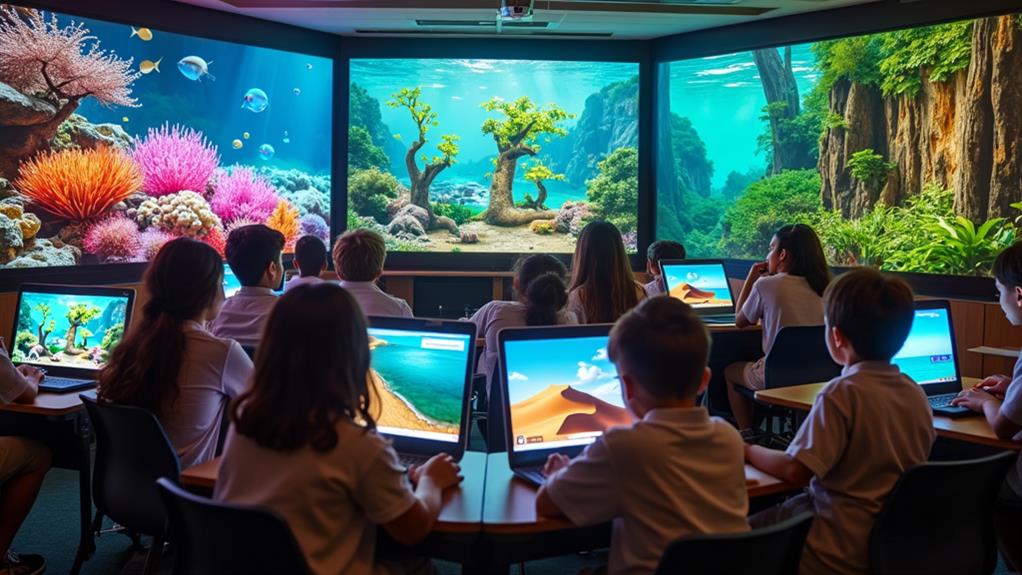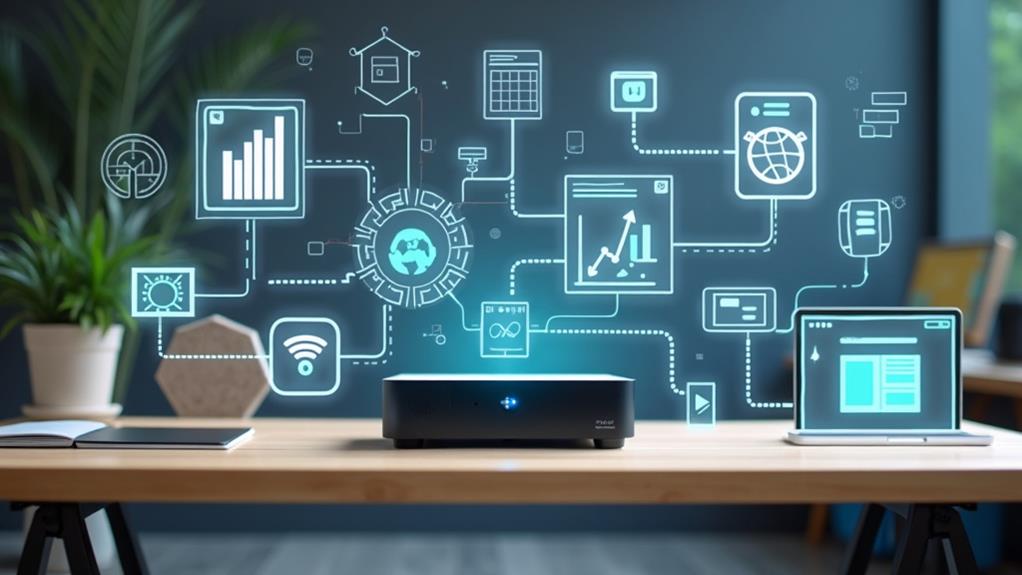



Recent advancements in human-computer interaction (HCI) greatly improve mini PCs, making them more user-friendly. Innovations like voice-guided interfaces allow for hands-free control, increasing accessibility for everyone. Gesture recognition systems create intuitive command execution, enhancing interaction without traditional input devices. Eye-tracking technology empowers those with mobility challenges to navigate with their gaze, fostering independence. Touchscreens and personalized user interfaces further engage users, tailoring experiences to individual preferences. As these features evolve, they contribute to a more efficient and enjoyable computing environment. By exploring further, you can uncover more about how these advancements transform your interaction with mini PCs.
Key Takeaways
- Voice-guided interfaces improve accessibility, enabling hands-free operation and streamlined task management on mini PCs.
- Gesture recognition systems facilitate intuitive control and navigation, enhancing user interaction without traditional input devices.
- Eye-tracking technology empowers users with disabilities to navigate mini PCs effectively using gaze direction.
- Advanced touchscreen capabilities enable direct manipulation of applications, improving engagement and overall user experience.
- Personalized user interfaces utilize machine learning to tailor experiences to individual preferences, enhancing usability on mini PCs.
Overview of Mini PCs
Mini PCs represent a significant shift in computing, catering to those who need powerful performance in a compact form. Their compact size allows you to integrate them into everyday life, whether you're working from a small home office or traveling for business. With a volume that occupies only about 1/30 that of traditional desktops, mini PCs deliver versatility that traditional machines can't match. Additionally, their durability and build quality are designed to withstand daily wear and tear, ensuring long-term reliability. You'll appreciate their low power consumption, which contributes to energy efficiency and reduces overall environmental impact. Many models utilize integrated graphics, ensuring you won't sacrifice performance for size. This makes them ideal for various applications, from home entertainment to educational purposes, supporting a wide array of operating systems and software.
Furthermore, the user experience is enhanced by flexible connectivity options like HDMI, USB, and Ethernet, seamlessly fitting into existing infrastructure. Their affordability allows for easy deployment in diverse settings—be it healthcare, finance, or educational institutions—offering robust IT solutions without overwhelming physical space. By choosing mini PCs, you're not just investing in a computer; you're embracing a new way to optimize your workspace while minimizing your environmental footprint.
Human-Computer Interaction Defined
Understanding human-computer interaction (HCI) is essential for optimizing how you engage with technology, especially in the context of mini PCs. HCI examines the design and use of computer technology, focusing on the interfaces between you and the devices. Its roots trace back to the 1980s, a time when personal computing began to flourish, highlighting the need for user-centered design. This emphasis on intuitive interfaces greatly enhances your user experience, particularly with the compact nature of mini PCs. Mini PCs, with their improved workflow efficiency, benefit from HCI advancements that facilitate quick access to patient records and reduce physical clutter in workspaces, which is essential in healthcare settings.
As technology advances, interaction methods have evolved, incorporating touchscreens and voice commands, making mini PCs more accessible for various applications like home entertainment and office work. HCI principles guarantee that even with limited space and power, these devices provide user-friendly features, enabling efficient task handling and seamless connectivity. Ongoing advancements in HCI, such as gesture recognition and eye-tracking technologies, promise to make your interactions with mini PCs even more intuitive. By understanding these elements of HCI, you're better equipped to appreciate how technological advancements can lead to a more satisfying and streamlined experience with your mini PC.
Historical Context of HCI
As personal computing began to gain traction in the 1970s, the study of human-computer interaction (HCI) emerged as an essential field focused on improving how users engage with technology. The early emphasis on usability in desktop environments paved the way for the user-friendly interfaces we now expect from devices like mini PCs, which require robust performance for tasks such as streaming and broadcasting. In the context of these demands, performance specifications like high-speed processors and dedicated graphics cards have become critical to delivering seamless user experiences. In 1983, the first HCI conference marked a pivotal moment, formally recognizing HCI as a distinct discipline dedicated to enhancing user experience.
Throughout the years, interaction methods evolved considerably, moving from traditional physical devices like keyboards and mice to more intuitive technologies such as touchscreens and voice recognition. This evolution has been crucial for mini PCs, which rely on compact designs that prioritize efficiency and user accessibility.
Research in HCI has consistently driven advancements in user-centered design, ensuring that mini PCs cater to a variety of user needs and preferences. By focusing on usability and creating adaptable user interfaces, HCI has transformed how you interact with these devices, making technology more inclusive and easier to navigate. Ultimately, the historical context of HCI illustrates its essential role in shaping the technology you use every day.
Key HCI Innovations
Revolutionizing user interaction, key innovations in human-computer interaction (HCI) have greatly enhanced the way you engage with mini PCs. Voice-guided interfaces allow you to control your device hands-free, simplifying access to information through natural language commands. This innovation not only saves time but also makes technology more accessible, especially for those with mobility challenges.
Eye-tracking technology introduces an intuitive way to interact with your mini PC, letting you navigate and control applications using just your gaze. This is particularly beneficial for individuals with disabilities, providing them with a more inclusive experience. Touchscreen functionality further elevates user experiences, enabling direct manipulation of applications and media, making navigation feel more engaging and natural.
Gesture recognition systems allow you to perform commands with simple hand movements, creating a seamless interaction that feels almost instinctive. Additionally, the development of personalized user interfaces tailors your experience to suit your individual preferences and behaviors, leading to more efficient and satisfying interactions. Collectively, these key HCI innovations transform how you interact with mini PCs, making technology more user-friendly, responsive, and adaptive to your needs.
Impact of HCI on Mini PCs
The impact of human-computer interaction (HCI) on mini PCs is profound, reshaping how you engage with technology in your daily life. Mini PCs offer a range of intuitive user interfaces that make maneuvering and controlling applications effortless. This enhanced usability stems from advancements in HCI, which prioritize user-centered design, guaranteeing that devices meet your specific needs.
Voice-guided interfaces, powered by AI assistants, simplify interactions, particularly improving accessibility for individuals with disabilities or those unfamiliar with traditional input methods. Furthermore, eye-tracking technology empowers users with mobility challenges, enabling them to control their devices using just their eye movements. This considerably broadens their interaction capabilities.
Gesture recognition systems further enhance your experience by providing touch-free interactions. This is particularly valuable in cramped spaces or for users with physical limitations, allowing for a more natural engagement with your mini PC. Additionally, the continuous focus on user-centered design leads to the development of compact, energy-efficient models that seamlessly fit into various environments. These innovations collectively guarantee that mini PCs not only adapt to your lifestyle but also enhance your overall efficiency and enjoyment.
Emerging Technologies in HCI
While you navigate the domain of mini PCs, emerging technologies in human-computer interaction (HCI) are reshaping how you engage with these devices. Voice-guided interfaces like Cortana and Alexa not only enhance user experience but also promote accessibility, allowing hands-free operation through natural language processing. This is especially beneficial for users with varying literacy levels. Meanwhile, eye-tracking software empowers individuals with disabilities, enabling them to control their mini PCs using just their eye movements, considerably improving accessibility and interaction.
Gesture recognition technologies are also making strides, allowing intuitive control through natural hand movements, which reduces reliance on traditional input devices like keyboards and mice. Additionally, augmented reality (AR) applications integrated with mini PCs create immersive experiences that enhance both productivity and entertainment, overlaying digital information onto your physical environment.
Lastly, the rise of wearable technology complements mini PCs by facilitating seamless health monitoring and data integration. This means you can access essential information without traditional input methods, further enhancing your overall user experience. These advancements in HCI not only make technology more intuitive but also more inclusive, catering to a diverse range of users and needs.
Future Trends in HCI
Increasingly, future trends in human-computer interaction (HCI) promise to redefine your experience with mini PCs in profound ways. Voice interaction technology is expected to revolutionize usability, allowing you to control devices and access information effortlessly through voice commands. With projected adoption rates surpassing 80% in the next five years, your interactions will feel more natural and efficient.
Gesture recognition systems will further enhance your experience, enabling you to navigate applications with intuitive hand movements. This development is not just about convenience; it notably improves accessibility for users with diverse needs. Eye-tracking technology will also emerge as a game-changer, letting you control your mini PC simply by directing your gaze, which can be especially beneficial for users with disabilities.
Moreover, the integration of augmented reality (AR) and virtual reality (VR) technologies promises to create immersive environments that elevate both productivity and entertainment. As user interface design continues to evolve towards more intuitive and user-friendly experiences, mini PCs will become increasingly accessible and efficient for everyone. These trends collectively point to a future where human-computer interactions are seamlessly integrated into your daily life.
Enhancing User Experience With HCI
User experience with mini PCs is being transformed by innovative HCI advancements that prioritize accessibility and ease of use. These developments notably enhance user interaction, making technology more approachable for everyone. Voice-guided interfaces like Amazon Alexa and Google Assistant allow you to control your device hands-free, streamlining tasks and improving efficiency.
Moreover, the integration of eye-tracking technology enables you to navigate your mini PC using just your gaze. This advancement is particularly beneficial for users with disabilities, enhancing accessibility and delivering a more intuitive experience. Touchscreen capabilities also align with modern interface design trends, allowing you to engage directly with content in a natural manner.
Gesture recognition systems further revolutionize how you interact with mini PCs. By using simple hand movements, you can control functions without traditional input devices, creating a more immersive interactive experience. Enhanced connectivity options, such as USB-C and HDMI, guarantee seamless integration with various peripherals, boosting productivity and versatility.
Together, these advancements create an ecosystem that not only prioritizes user needs but also fosters a more inclusive, intuitive, and engaging interaction with technology.
Disclosure: As an Amazon Associate, I earn from qualifying purchases.






